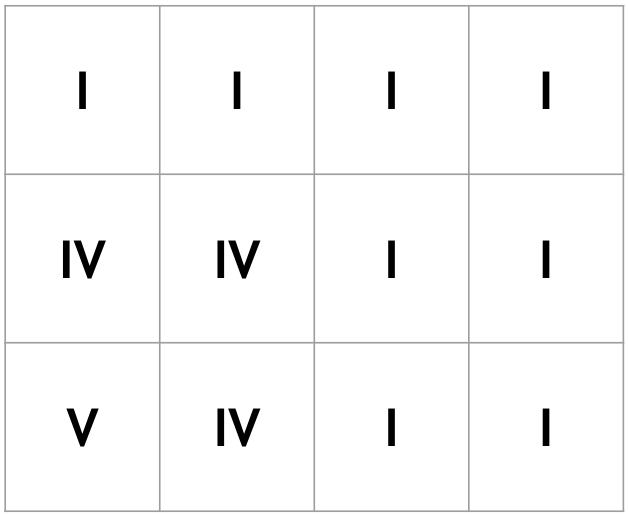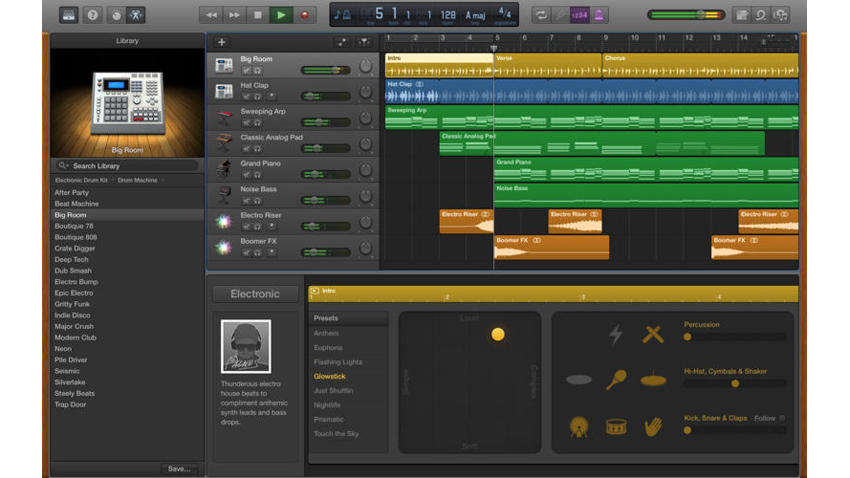- The 12 Bar Blues in a Tango Style? If you’re looking for a blues activity that’s a little different – and you have some iPads you can use during class – you might like to ask students to “transform the blues” using the GarageBand app.
- The 12-Bar Blues form is called that because it has a chord progression that takes place over 12 bars, or measures. The chord progression uses only the I, IV, and V chords of a key, also called the tonic, subdominant, and dominant, respectively. The 12 bars are broken up into three groups of four.

GarageBand Projects 3 About these instructions 3 Maths Rap 3 Cross-Curricular Activity 3 Create a new project 3 Add a drum or percussion loop 3 Record your rap 3 Edit mistakes 4 Extensions 4 Basic mixing 4 Create a project fade-in and/or fade-out 4 12 Bar Blues 4 Create a new project 4 Choose a bass loop 4 Building the bass line 5. Your Email Title should be “12 Bar Blues” and your UA Day number ex: 12 Bar Blues UA1; Attach your saved garageband project to the email; send the email to me (lmurphy@falmouthschools.org) and to yourself! Make sure you can open the email! DONE; Step By Step Video on How to Complete This Project! Make sure you start off with a song writing.
My StudyBass
What is the Blues Form?
As I mentioned in about the blues, a song form is a structure, or a kind of formula, for a piece of music. The blues form is a specific song structure used in the blues as well as other styles inspired by the blues like rock, jazz, R&B, etc.
Applying the I, IV, and V Chords
The blues uses the I, IV, and V chords throughout the song form. If you’re unfamiliar with the concept of the I, IV, and V chords, make sure you go through that lesson before continuing.
There are many variations of the blues. First I’m going to teach you the most common form that confuses students the least. Later in the lessons we’ll look at the many other variations.
Garageband 12 Bar Blues Song
The 12-Bar Blues Form
The most common form of the blues is a 12-bar pattern of chord changes. That is, a repeated twelve-bar chord progression. This is called “12-Bar Blues”.
You should remember a bar is the same as a measure. Most often in blues you will count 4 beats to each bar – 4/4 time.
In a blues song this 12-bar cycle gets repeated over and over through the course of the tune. A blues song might play through it 20 times. It will depend on the specific song.
The blues can be played in any key. In whatever key you are in, 12-bar blues uses the same basic sequence of I, IV, and V chords. It is most easily thought of as three 4-bar sections – the first 4, the middle 4, and the last 4 bars.
The first 4 bars just use the I chord - I, I, I, I.
Garageband 12 Bar Blues Music
The middle 4 bars go IV, IV, I, I.
And the last 4 bars go V, IV, I, V. Then you repeat the whole thing again.
So, the basic 12-bar sequence looks like this:
Plugging In the Chords from a Key
To get the blues chord progression for the blues in A, we take the I, IV, and V chords from the key of A. That means A is I, D is IV, and E is V. Then, we plug those three chords into the corresponding places in the blues form. We end up with this set of chord changes:
For the blues in any other key, we’d do the exact same thing. Blues in C would plug in the chords C, F, and G into the 12-bar blues structure. Blues in E would use E, A, and B. And, so on. There are 12 major keys; you can play the blues in any one of them.
Playing the Blues Form
The first step in learning to play the blues is getting comfortable with where the chords change. You need to memorize and completely internalize this sequence of chords. You can’t ever get lost wondering to yourself, “What chord is next?” With enough time and practice, you'll just hear and feel what the next chord change is. In the beginning you may have to really concentrate on the changes.

The Blues Form Exercises
In the blues form exercises we’ll outline each chord with its root note. You should be able to do this by yourself with a metronome and never miss a chord. You might record yourself to make sure you aren’t skipping any!
Once you have that down, we’ll apply more notes to the same set of chords. That’s when it’ll start to sound more like the blues and get more fun. Don’t fall asleep on me!
OPEN THE FILE AT THE BOTTOM OF THE PAGE FOR SCREENSHOTS OF WHAT THE PROJECT SHOULD LOOK LIKE
Set Up:
- Open GarageBand - Select “Songwriting”
- Title your project “12 Bar Blues”
- Delete Voice Master Track
- Delete Acoustic Guitar Master Track
- Drag back your drum beats so they last for 12 bars
Bass Line:
- Select the “Muted Bass” Instrument master track
- Open “Musical Typing”
- Go to “Control Menu” and check off “Count In” - this will give you four beats to get ready with.
- Record Roots of the 12 bar blues
- Do---|Do---|Do---|Do---|Fa---|Fa---|Do---|Do---|Sol---|Fa---|Do---|Do---||
Edit:
- Open Track Editor
- Quantize Note Timing - 1/4 Note
- Drag notes to correct pitch
- Drag notes so they start at the beginning of the bar
- Close track Editor
Chords:
- Select the piano master track
- Copy and paste the muted bass track into the piano part
- Add a New Track - Software Instrument
- Drag the New Piano Master Track to the top of the list
- Open “Musical Typing”
- Record the following with four notes per bar:
GAGA | GAGA | GAGA | GAGA |
CDCD | CDCD | GAGA | GAGA |
DEDE | CDCD | GAGA | GAGA |
Garageband 12 Bar Blues Chords
on the keyboard this would look like
GHGH | GHGH | GHGH | GHGH |
ASAS | ASAS | GHGH | GHGH |
SDSD | ASAS | GHGH | GHGH |
Edit:
1. Open Track Editor


- Quantize Note Timing - 1/4 Note
- Edit incorrect pitches
- Adjust Muted Bass so the volume is all the way up
SAVE SAVE SAVE SAVE SAVE SAVE SAVE SAVE SAVE SAVE SAVE
Submit:
- Open your email
- Your Email Title should be “12 Bar Blues” and your UA Day number ex:
- 12 Bar Blues UA1
- Attach your saved garageband project to the email
- send the email to me (lmurphy@falmouthschools.org) and to yourself!
- Make sure you can open the email!
- DONE
Step By Step Video on How to Complete This Project!
Make sure you start off with a song writing project!